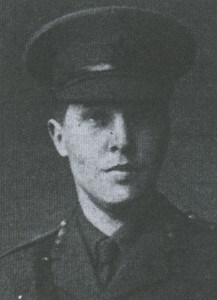Thank you to John Callcut for letting us reproduce the following information, taken from his book: A Village at War. Newdigate in World War One.

John Collett Tyler was born on the 9th December 1893 in the foothills of the Himalayas at Roorkee, which is in the northern India state of Uttatakhand. He was the second son of Col. John Charles Tyler, Royal Engineers and Florence Mary, and a grandson of Sir Henry Whatley Tyler. The family owned Woodlands Farm in Newdigate and it was here that a daughter Rosamund, was born in 1905. John Collett Tyler was educated at Wellington College from 1909-1911 where he was head of the school and captain of football, and at the Royal Military Academy where he was senior under-officer and obtained the Sword of Honour in July 1914.
The Commandant in his report on that occasion, observed that he would especially mention Senior Under-Officer J.C. Tyler, who had shown in his present responsible position that he possessed in a high degree those qualities which were looked for in the best type of officer. He was gazetted 2nd Lieutenant, R.F.A. on the 17th July 1914 and joined at Woolwich on the 9th August, left for Dundalk, Ireland on the 10th and embarked for France on the 17th.
Hill 60 was an artificial ridge, 60 metres high, made from the spoil from a railway cutting which had been dug many years before. It had been captured by the Germans in December 1914 and the British were determined to regain it as it afforded a good observation point. Tunnels had been dug under the hill by the 171st Tunneling Company and a charge of 2700 pounds was laid in each chamber. At 19.00 hours on the 17th April the plunger was hit and debris flew 300 yards into the air. The British took the hill – only to lose it again that night when the Germans counter-attacked. The next day the hill was again retaken but during this attack 2nd Lieut. Tyler was killed. The Major commanding his battery wrote on the 21st April, ‘There is a big battle going on here now which started at 7.00p.m. on the 17th, John and I went forward that day to observe. I had to send John and a signaler on by night, to the newly captured trench to let me know if the Germans were counter-attacking, and to observe by day. This job he did in his usual gallant way. Three times he came back to me under heavy fire and great difficulties to mend the telephone lines. He was shot at dawn, a rifle bullet clean through the forehead. He died, as he lived, doing his duty gallantly and well. Had he lived he would have certainly had the D.S.O. He was killed in the foremost trench captured from the Germans. Just after he was killed the Germans retook the trench and held it for about twelve hours. We then took it back.’ The General Officer Commanding wrote a few days later, ‘I had already sent in his name for good service. His cheery, gallant example was worth everything at these times’.
His name is recorded on the Menin Gate, the Colchester War Memorial and the Wellington College Roll of Honour.
| Born | Roorkee, Uttarakhand, India | |
| Son of | Colonel John Charles and Florence Mary Tyler | |
| Grandson of | Sir Henry Whatley Tyler | |
| School | Wellington College, Berkshire | |
| College | Royal Military Academy, Woolwich | |
| Regiment | 122nd Battery, Royal Field Artillery | |
| Date of Death | 18th April 1915 | |
| Place of Death | Hill 60, Flanders, Belgium | |
| Cause of Death | Killed in Action | |
| Age | 21 | |
| Memorial | Ypres (Menin Gate) Memorial, Belgium |
Last : Alfred H. Tyler
Next : Ernest Weller

